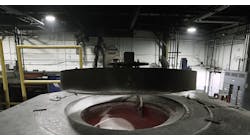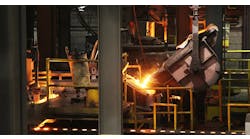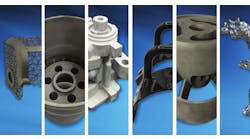For foundries operating induction melting and pouring systems there has long been a negative association with the use of fluxes for ferrous metal production. Refractories commonly used in induction furnaces, such as silica-based linings, are very prone to chemical attack from fluxes. In many ferrous melt shops, mixtures of lime/fluorspar (CaCO3/CaF2) are commonly added, for desulphurization, phosphorus reduction, deoxidation, coke cleansing, or to improve metal cleanliness. However, recent changes in flux formulations, by eliminating chlorides and fluorides, has seen remarkable successes in induction melting and pouring operations. In the past, these types of furnaces might have been removed from service prematurely because of the inability to effectively and safely remove stubborn slag and insoluble build-up from the sidewalls.
A typical example of what frequently happens when poor quality, dirty, sand-encrusted charge materials are used is illustrated below. This small iron foundry (Foundry X) that had great success utilizing new-fluoride free flux additions in a 500-lb., medium-frequency coreless induction furnace to combat slag build-up.
Foundry X is a small, family-owned plant that had noticed unexpected “lining growth” in their 500-lb. coreless induction furnace. The slag build-up on the lining was increasing at the rate of 25 mm (1 in.) per day. A 2-in.-thick layer of build-up occurred after only two days of operation. Attempts to remove the build-up with a chipping hammer were abandoned out of concern of damaging the lining, and creating a safety issue. The build-up soon became an emergency situation due to the rapid reduction of the furnace capacity and resulting loss of casting production.
Slag build-up from the furnace sidewalls was analyzed and found to be a combination 2MnO·SiO2, tephroite, and 2FeO·SiO2, fayalite. The assay of the build-up was: 69.4% SiO2, 11.2% FeO, 6.7% MnO, 6.6% Al2O3, 2.7% CaO, and 1.7% MgO. It was noted that the FeO and MnO levels were much higher than normal.
Superheating the molten metal bath at the end of the heat was attempted, to remove the build-up, but this procedure did not work. However, success was achieved only when continuous Redux EF40 (Patent 7,618,473B1), fluoride-free flux additions were made to the charge (1 lb. of flux per ton of metal.) The foundry was able to re-establish the furnace capacity without any damage or wear to the silica refractory lining.
Later it was discovered that a change to a new pig iron source coincided with the appearance of a sponge-like, foamy black slag in the furnace. The foamy black slag resulted from high amounts of iron oxide in the pig iron. Foundry X continued to use that pig iron but it modified the charge to keep the build-up manageable. This included the continuous use of flux.
Initially, Foundry X could barely continue to melt through three days of operation. After incorporating the flux into the charge, even with the “very rusty pig iron,” the operators returned to the normal two-week production cycle without relining the furnace. There was no longer any doubt about the effectiveness of the flux and any potential damage to the working lining.
Currently, mild fluxes like Redux EF40 can increase lining life in induction ferrous melting, while preventing insoluble build-up deposition. Many case histories in coreless induction furnaces, channel induction furnaces, press pouring furnaces, and ladle applications, have proven to be successful. Now, iron foundries do not need to fear using fluxes, they just need to use them properly, as prescribed by the manufacturer.
Rod Naro is president and CEO, and David C. Williams is v.p. - Technology of ASI International Ltd. Visit www.asi-alloys.com










